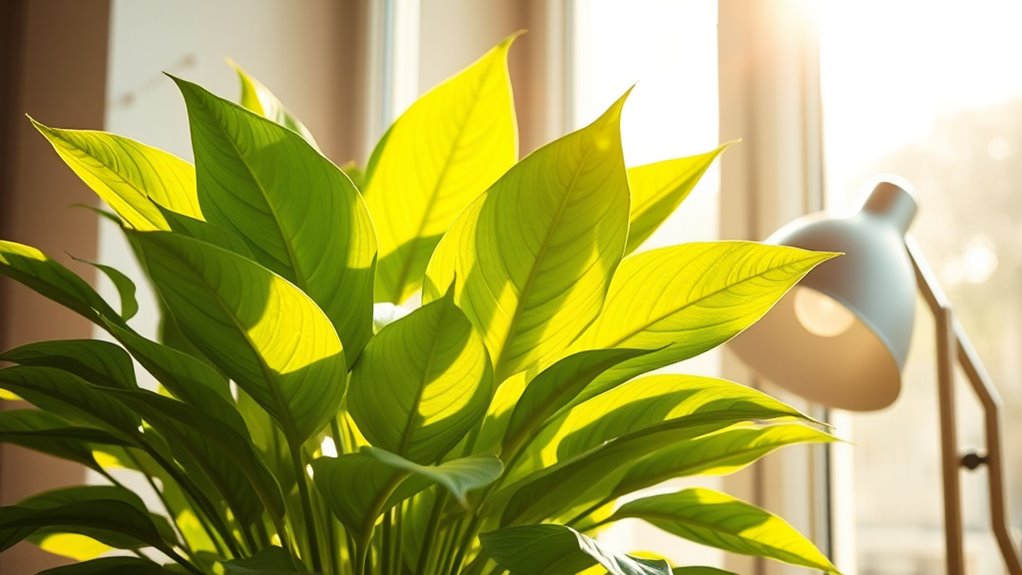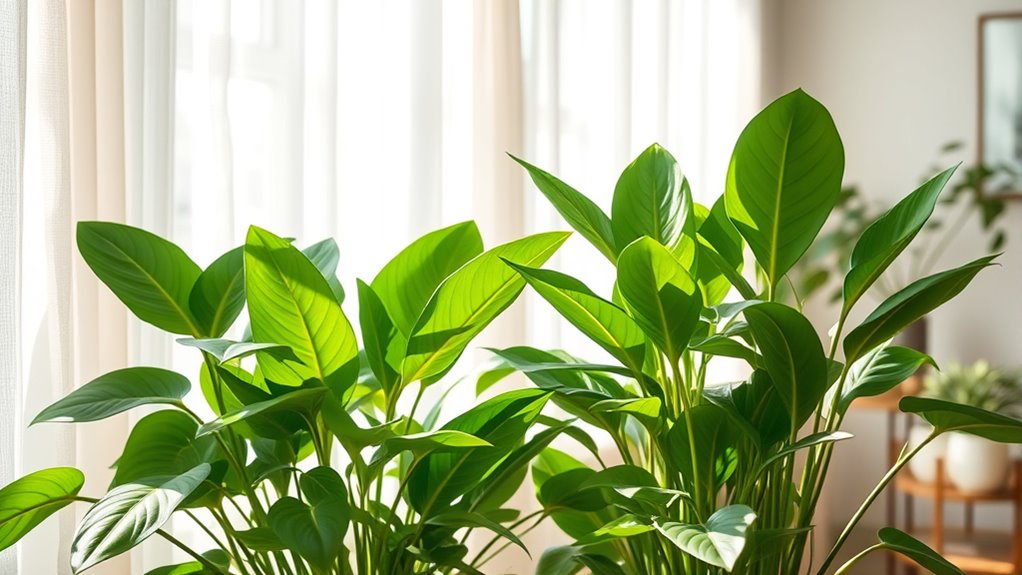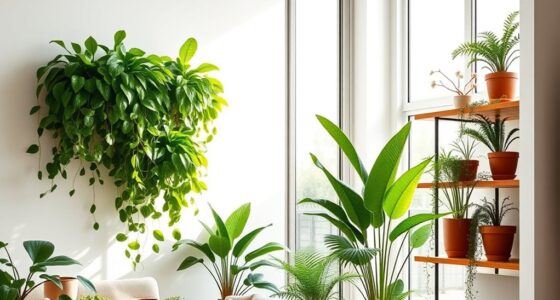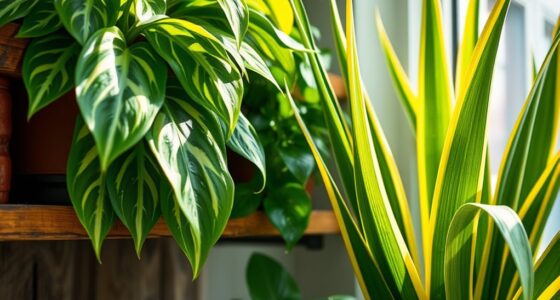To keep your indoor plants healthy, make certain they get the right amount of light by placing them near south-facing windows or using artificial LED grow lights if natural sunlight is limited. Keep windows clean and rotate plants regularly for even exposure. Match light types to plant needs—bright for succulents, low for ferns—and use timers to maintain consistent cycles. Curious about optimizing your setup? Continue exploring for expert tips to boost your plant’s vitality.
Key Takeaways
- Ensure your indoor plants receive adequate light by placing them near south-facing windows or supplementing with grow lights.
- Keep windows clean and avoid shaded corners to maximize natural sunlight exposure.
- Use energy-efficient LED grow lights with appropriate spectrum for your plant types, and position them close without overheating.
- Adjust lighting duration to 12-16 hours daily with timers to promote healthy growth.
- Rotate plants regularly and observe their responses to optimize light exposure and prevent leggy or unhealthy growth.

Proper lighting is fundamental for keeping your indoor plants healthy and vibrant. Without adequate light, plants can become leggy, lose their color, or even die. You have two main options when it comes to lighting: artificial lighting and natural sunlight. Understanding how to balance and optimize both can make a big difference in your plants’ growth and overall health.
Natural sunlight is usually the best source of light for indoor plants because it provides a full spectrum of wavelengths that plants need for photosynthesis. However, the amount of sunlight that filters into your home varies depending on the window orientation, the season, and any obstructions like blinds or curtains. South-facing windows typically give you the most consistent and intense sunlight, making them ideal spots for light-loving plants. East- and west-facing windows offer gentle morning or afternoon sun, suitable for plants that prefer less direct light. North-facing windows tend to be shadier, which is better for low-light plants but may not suffice for those that need more brightness. To maximize natural sunlight, keep your windows clean and avoid placing plants in shaded corners. If sunlight is limited, supplement your plants with artificial lighting.
Artificial lighting becomes indispensable when natural sunlight isn’t enough or during winter months. LED grow lights are popular because they are energy-efficient, produce less heat, and can be tailored to emit specific light spectrums that promote healthy growth. When using artificial lighting, position the lights close enough to your plants—usually within a few inches—to provide sufficient intensity, but avoid placing them so close that they cause heat stress. The duration of light exposure is also important; most indoor plants thrive with about 12 to 16 hours of light per day. Use timers to automate this process, ensuring your plants get a consistent light cycle that mimics natural conditions.
You should also pay attention to the type of light your plants require. For instance, succulents and cacti prefer bright, direct light, whether natural or artificial, while ferns and pothos can tolerate lower light levels. Rotating your plants regularly helps ensure all sides receive equal light exposure and encourages even growth. Additionally, understanding the importance of light spectrum can help you choose the right artificial lighting for your plant’s specific needs.
Ultimately, striking the right balance between natural sunlight and artificial lighting will keep your indoor plants happy and thriving. Observe how your plants respond—if they stretch toward the light or lose their vibrant color, adjust the lighting accordingly. With a little experimentation and attention, you’ll create an environment where your indoor plants flourish, adding beauty and vitality to your home.
Frequently Asked Questions
How Can I Tell if My Plant Is Getting Too Much or Too Little Light?
If your plant shows signs of leaf yellowing, scorched edges, or plant stress, it might be getting too much light. Conversely, if leaves are pale, growth slows, or you notice light deficiency symptoms, your plant isn’t receiving enough light. Adjust its placement accordingly—move it closer to a light source or farther away. Monitoring these signs helps make certain your plant gets the right amount of light for healthy growth.
Which Artificial Lighting Options Are Best for Indoor Plants?
Surprisingly, your best options are LED grow lights and fluorescent tubes. LED grow lights are energy-efficient and customizable, providing the right spectrum for healthy growth. Fluorescent tubes are budget-friendly and great for low-light spaces. Both options give your plants the light they need without the sun’s unpredictability. So, forget natural light struggles—these artificial choices make indoor gardening a breeze, no matter how gloomy outside.
How Does Light Intensity Affect Different Types of Indoor Plants?
You’ll find that light intensity impacts indoor plants differently based on their light spectrum needs. For example, low-light plants thrive with gentle, indirect natural light or soft artificial light, while high-light plants require intense, direct light, whether natural or artificial. Understanding the difference helps you choose the right environment. Balancing natural versus artificial light ensures your plants receive the most suitable light intensity, promoting healthy growth and vibrant foliage.
Can I Use Window Films to Optimize Indoor Plant Lighting?
Yes, you can use window films to optimize indoor plant lighting. They provide UV protection, reducing harsh rays that can harm your plants, while still allowing sufficient light to pass through. Plus, window films add an aesthetic enhancement to your space, making it look stylish while supporting healthy plant growth. Just choose a film designed for plant health, and adjust it to maximize light without sacrificing your decor’s appeal.
How Often Should I Rotate Plants to Ensure Even Light Exposure?
You should rotate your plants about once a week to guarantee even light exposure. Regular plant rotation helps prevent uneven growth caused by light coming from one direction. By turning your plants, you give all sides equal access to light, promoting healthy, balanced growth. Keep an eye on your plants’ positioning and make adjustments as needed, especially if you notice one side leaning or growing faster than the other.
Conclusion
By following these lighting tips, you’ll create a cozy sunlit haven where your indoor plants can thrive. Think of your plants as happy guests at a well-lit party—they flourish when they get just the right amount of light. Keep an eye on their needs, adjust as seasons change, and watch your green friends grow healthy and strong. With a little attention, your home will become a lush oasis, glowing with vibrant life.









